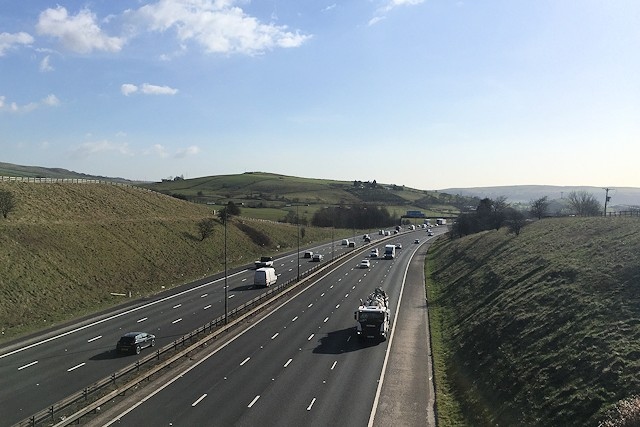Taking to the roads this May bank holiday? Here’s some good advice from a Highways England traffic officer
Date published: 27 May 2021

Some cars have been rarely used in recent months, so it’s essential to make sure they’re fit for purpose (pictured: the M62 towards Milnrow)
If you are using your vehicle for the first time in a while this May bank holiday, Highways England Traffic Officer Dave Harford has some important advice.
Some cars have been rarely used recently, so it’s essential to make sure they’re fit for purpose, especially if you are heading out on a long journey.
Any vehicle that hasn’t been on the road for some time will need a thorough check to ensure it is roadworthy and safe and now is a good time to give your car a spring clean and make sure it’s ready.
Dave, who appears in a Highways England video, said: “If you haven’t driven for a while due to lockdown, you might feel a bit strange getting back behind the wheel.
“So it’s really important that you spend some time carrying out a few simple checks to ensure your vehicle is roadworthy before setting off on your journey.
"Checking your tyres, oil, screenwash, lights and fuel doesn’t take long – but it will help keep you and your loved ones safe.”
Here are some simple regular car checks that drivers can do to help avoid breakdowns:
Check tyres: prior to setting off on a long/significant journey, check your tyre pressures are suitable for the load and check the condition of your tyres, including the spare. Look out for cuts or wear and make sure that you change your tyres at a tread depth of 2mm because although the legal limit is a minimum tread depth of 1.6mm, changing them ahead of that point is always good practice.
Check engine oil: use your dipstick to check oil regularly and before any long journey, and top up if needed. Take your car back to the garage if you’re topping up more than usual.
Check water: to ensure you have good visibility, always keep your screen wash topped up so you can clear debris or dirt off your windscreen.
Check lights: if your indicators, hazard lights, headlights, fog lights, reverse lights or brake lights are not functioning properly, you are putting yourself and your family at risk. In addition, light malfunctions can be a reason for your vehicle to fail its MOT.
Check fuel: before setting out, check your fuel levels and make sure you have enough to get to your destination.
Four million journeys are made every day on the country’s busiest roads – motorways and major A-roads – and most are incident-free. But around 600 journeys per day involve a breakdown, and when you are on a busy motorway that can be frightening.
In 2019 there were almost 230,000 reported breakdowns across the Highways England network including around 207,500 on motorways. In the 12 months from June 2019, around 40,000 breakdowns were recorded as being due to tyre issues while more than 6,000 incidents were a result of vehicles running out of fuel.
To help people understand what to do in the event of an unexpected vehicle breakdown, Highways England recently launched a public information drive, giving motorists clear advice about what to do in an emergency.
The Go Left campaign has been backed by leading road safety organisations.
The advice to drivers who experience a problem with their vehicle is to leave the motorway if possible. But if that is not possible, Highways England recommends the following:
Go left
- put your left indicator on and move into an emergency area, onto a hard shoulder, motorway service area, left-hand verge or A-road lay-by
- switch your hazard warning lights on, even during the day. If it’s dark, use side lights and in poor visibility use fog lights as well
- on a motorway without a hard shoulder, it should be possible for most vehicles experiencing a problem to reach an emergency area. These are regularly spaced and are marked by a clearly visible orange road surface and blue signs featuring an orange SOS telephone symbol
Get safe
- if it is safe to do so, and you can get out with any passengers, exit your vehicle on the side furthest from traffic. If it is not safe to do so, stay in your vehicle and wait for help
- keep well away from moving traffic and your own vehicle. Get behind a safety barrier where there is one, and where it is safe to do so. If you’re on a verge, be aware of any unseen hazards such as uneven ground or debris
Get help
- contact Highways England on 0300 123 5000 and then a breakdown recovery provider
- if you are unable to exit your vehicle and get to a safe place, have stopped in a live traffic lane or feel your life is in danger, stay in your vehicle with your seatbelts and hazard lights on and call 999 immediately
Highways England’s customer contact centre has people on hand 24 hours a day, 365 days a year to help. Drivers should keep the Highways England number – 0300 123 5000 – in their phones in case of emergency.
For advice about what to do in a breakdown visit: https://highwaysengland.co.uk/breakdowns/
Do you have a story for us?
Let us know by emailing news@rochdaleonline.co.uk
All contact will be treated in confidence.
Most Viewed News Stories
To contact the Rochdale Online news desk, email news@rochdaleonline.co.uk or visit our news submission page.
To get the latest news on your desktop or mobile, follow Rochdale Online on Twitter and Facebook.


